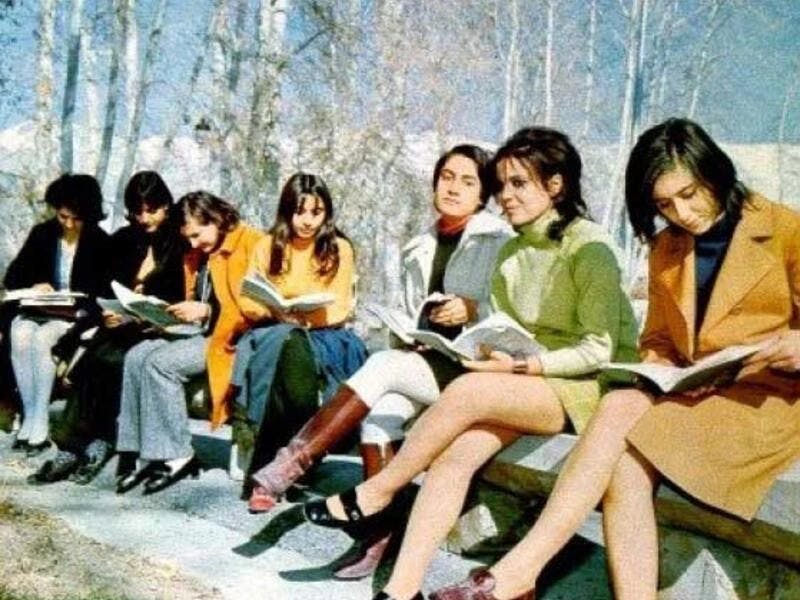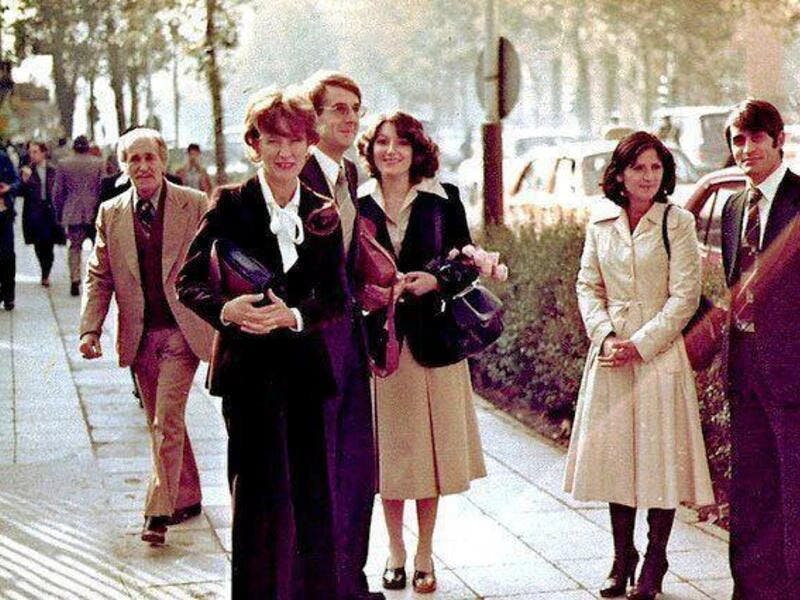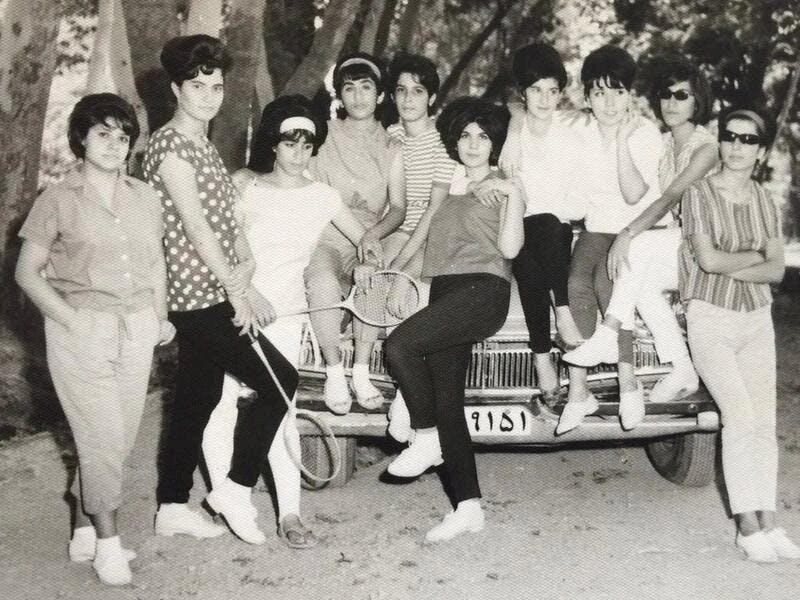‘The Handmaid’s Tale’ Is More Like Iran Than Modern America
When Margaret Atwood was asked about how she was inspired to come up with the fictional events of Gilead in her bestselling 1985 book “The Handmaid’s Tale,” which has since been adapted into a critically acclaimed TV series, she stopped the interviewer.

“Nothing that I've written hasn't already happened and nothing that we build doesn't already exist,” Atwood said. While Gilead may be a fictional place set in a dystopian future within the United States, the events and subjugation of women’s rights that the fictional story is based upon are very real. As Atwood says, she didn’t just “make this all up” – she just relocated it to Cambridge, Massachusetts.
The inspiration for The Handmaid’s Tale certainly wasn’t limited to an isolated event, country, religion, or style of government. Rather, Atwood drew from a string of authoritarian and theocratic regimes which presently or historically have enforced the subjugation of women. This includes the Salem Witch Trials, allusions to The Old Testament, Shariah Law, polygamy in Mormonism and Islam, the ex-Catholic cult “People of Hope,” the Soviet Union, and the 1979 Islamic Iranian Revolution.
It’s the parallel to Iran that I would like to explore more closely. While many instances of injustice and the suppression of women’s rights can be found all over the world, the unique and seemingly implausible story of how a free and democratic society can transform into a theocratic authoritarian regime almost overnight is not one of fiction – it’s the story of the women of Iran.
The Veiling of Women and Stripping of Freedoms
Parallels between the Islamic Republic of Iran and Gilead are directly alluded to in The Handmaid’s Tale. Atwood references Iran in her book, mentioning a history book entitled Iran and Gilead: Two Late Twentieth Century Monotheocracies that is listed in the endnotes alluding to a historians' convention that happens in 2195. This is no coincidence, I believe. Both societies involve a government taking advantage of a crisis to impose their own forms of government which are based upon religious fundamentalism.
Iran is perhaps the only country in the world where historical photos predating the 1979 revolution look like they should be glimpses into the future, not the past. Under the Shah’s rule in Iran, women gained an increase in protections and rights, including the right to vote, the minimum age of marriage was raised from 13 to 18, and women were granted the right to request a divorce and to fight for custody of their child. Women even held high positions of power such as serving in parliament or on councils. A considerable number of women attended university and were part of the workforce. Education was free for both boys and girls.

Students from the University of Tehran, Iran ...before the Islamic Revolution in 1971.


"This is my mum & her friends in Iran before the Islamic revolution. All were professional, independent & free women." (via @RitaPanahi on Twitter.)
However, following the 1979 revolution, which saw protests against the autocratic government by both men and women, governmental control was seized by revolutionary leader Ayatollah Ruhollah Khomeini and Iran was soon under fundamentalist Islamic rule. Where women used to walk the streets unveiled, exposing their long hair and freely expressing themselves through their clothing and makeup, they would soon lose all of that. It became mandatory for women and girls to wear the hijab in public, starting at the age of 9.
By 1983, women who were unveiled in public were subject to 74 lashes by law, and in 1995, failure to veil become an imprisonable offense. Iran is the only other country besides Saudi Arabia where wearing a hijab is compulsory. Many women try to push the boundaries of what is an acceptable hijab by pushing it back to expose more hair, yet they are still forced by law to cover up. Comparatively, in The Handmaid’s Tale, women are conscripted to wear specific clothing according to their role in society. The handmaids must wear a red dress that covers their entire body, an additional red cloak is placed over it when going out in public, and they must always cover their hair with a white coif at home and an additional oversized white bonnet when in public. The dark red outfits symbolize fertility while white symbolizes purity and innocence.

The highest rank for a woman in Gilead is to be a wife. Wives wear teal, which symbolizes their subservience to their husbands. Marthas, who take care of the domestic household duties like cooking and cleaning, must wear a faded green color and also cover their heads. The aunts, whose role in society is to keep handmaids in line, teach them how to produce children for other families, and obey the laws, wear brown, the color of authority. Aunts are the only women in Gilead who are allowed to read. Failure to wear the proper attire, or follow any rule for that matter, has serious consequences. In later seasons, some handmaids even have their mouths sewn shut so they can’t speak. There is a striking similarity between the veiling of handmaids and the veiling of Iranian women, both of whom must cover their hair and bodies.
Women Are To Reproduce and Be Subservient to Their Husbands
In The Handmaid’s Tale, women are relegated to reproductive vessels to produce more children for the state and god. Because Gilead has been plagued by a fertility crisis, society’s core objective is to increase birth rates. They constructed a society that mandates reproduction. Fertile women have their biological children ripped away from them, are separated from their husbands, and are sentenced to life as a handmaid.
They’re placed with a family (a wife and a commander) and are legally raped by the commander in what they refer to as a monthly “ceremony” as the wife holds the handmaid down. The objective is for the handmaid to become pregnant and bear a child that she can’t keep, as the child legally belongs to the wife and commander. Handmaids are repeatedly raped until impregnated and then “reassigned” to another posting.
Young girls in Gilead are raised to learn how to be good future wives. They’re married off as young as 14. However, if they can reproduce and have sinned against Gilead, they will become handmaids.

Keeping this in mind, let’s look at Iran, where women lack autonomy in terms of marriage, reproduction, child custody, and divorce. There are many discriminatory laws in place based on gender. Men are considered the head of the household, so they retain the right to determine where the family will live, are entitled to custody of children once they pass a certain age (2 for boys and 7 for girls), and make all relevant legal decisions for children. Women must meet their husband's sexual needs, are only allowed to divorce their husbands in very particular circumstances, and victims of domestic violence must prove that the abuse was so severe that it was intolerable. Young girls are forced into child marriages. Specific numbers on child marriages are hard to find because they are lumped together with girls who are 18.
Polygamy is legally acceptable for men, who can marry up to four women simultaneously, but not for women, who can only have one husband. A woman must have the consent of a male guardian before getting married. Women are also restricted to only marrying a Muslim man, while men are free to marry outside their religion. While these are the laws, polygamy is not actually that common and most women marry in their twenties, not as children. While these practices may be less common, many children are still forcibly married against their will as long as their parents consent.
While some reforms have been introduced to increase the minimum age of child marriage from 9 to 13 years old for girls, additional calls to raise the minimum age to 18 have been blocked. Child marriages for girls under 13 can also be approved with a father’s consent. If a woman gets a divorce, she forfeits her right to the custody of her child should she ever remarry, even in cases where the husband has died. There is also a gender discrepancy in inheritance between men and women. A widowed man is entitled to his wife's entire estate, while a woman is only entitled to 1/8 of her husband's estate. Similarly, a son's inheritance will be double that of a daughter.
If a woman gets a divorce, she forfeits her right to the custody of her child should she ever remarry.
Another parallel between The Handmaid’s Tale and real-life Iran is that there is no free access to contraception in either Gilead or Iran. In Gilead, birth control is unsurprisingly banned and handmaids must go for routine checkups to check for pregnancy. Abortion, of course, is out of the question. Iran has recently introduced a law known as “The Youthful Population and Protection of the Family Law” which has rolled back women’s access to birth control and abortion.
The law restricts access to the free distribution of contraception, outlaws voluntary sterilization, and severely restricts access to abortion. Even in cases where the mother’s life is threatened or the child has a severe fetal anomaly, the final decision is to be decided by a panel made up of judiciary representatives, Islamic jurists, lawmakers, and doctors. The new law also put pressure on state television to produce programs that encourage childbearing and discourage being single. Prenatal screening tests which would reveal if a child could have Down's syndrome, Edward's syndrome, or Patau's syndrome have also been restricted. The purpose of this law was to incentivize an increase in the population’s birth rates, which have been stagnant. Sound familiar?
Governmental Force: Imprisonment, Executions, and Torture of Dissidents
Continuing the comparison, both societies repress women by stripping their freedoms. Gilead uses the full force of the government to deliver extreme punishments for minor violations of its laws. The aunts and the “eyes” enforce the rules of Gilead, including the dress code. Failure to follow the rules often leads to physical torture, imprisonment, public execution, or genital mutilation. In Gilead, women are not allowed to read, for which the punishment is to lose a finger. Adultery is punishable by execution, homosexuality is prohibited, and violators are considered gender traitors – the punishment being forced female genital mutilation and being sent to the colonies to clean up radioactive waste, where workers will inevitably die shortly after. Women can’t leave the house unattended, must look down when spoken to by an authority figure, and the list goes on and on.

Out of 144 countries ranked for gender parity, Iran ranked 140th. In Iran, women aren’t allowed to dance or sing in public, and doing so will result in arrest. They can’t attend sporting events or wear swimsuits, must remain segregated from men, and can’t ride a bike. The testimony of a woman is even worth half of a man’s. Many women have been imprisoned for taking off their hijab, protesting laws that subordinate women, or for attending prohibited events like sports games. In 2020, human rights lawyer Nasrin Sotoudeh was sentenced to 38 years in prison and 148 lashes for representing a woman who protested the mandatory hijab. Sahar Khodayari is a woman who tried to sneak into a soccer stadium disguised as a man so she could watch the game. She was caught and charged for wearing an improper hijab and having a confrontation with police. After she was threatened with 6 months in prison, she set herself on fire in front of the courthouse.
Closing Thoughts
When commenting on how authoritarian regimes come to power, Atwood has said, "It's a subtext for each and every one of the authoritarian regimes that have come in around the world. Many things are different about them. Their reasons for winning are different. But what they have in common is that they all want to roll back women's rights."
To the nearly 42 million women in Iran, living under an oppressive theocratic regime that robs them of their freedoms for being born with certain reproductive organs is an everyday reality, not an exaggeration. While many in the West make excuses for women who veil, they often miss the point that veiling isn't a choice. It should go without saying that no society can call themselves free or just while imprisoning women based on whether or not they cover their hair. To the millions of women struggling for freedom in Iran right now, we have one message for you – the same one a handmaid left for June Osbourne: “Nolite te bastardes carborundorum.” Don't let the bastards grind you down.
Readers make our world go round. Make your voice heard in the official Evie reader survey.